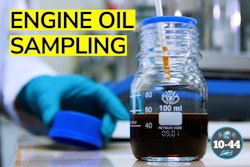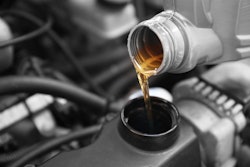Last month we covered how important it is to sample your oil, but just like anything else, how you do something is just as important as that you do something.
As simple as it sounds, there is a right and wrong way to collect oil samples for lab testing, and incidental contaminants are going to affect the results.
Contents of this video
00:00 10-44 intro
00:27 Collecting engine oil samples
00:57 Contaminated samples
01:42 Best practices for collecting samples
04:16 When to pull an engine oil sample
05:02 Properly filling out the paperwork
Jason Cannon:
CCJ's 10 44 is brought to you by Chevron Delo, heavy duty diesel engine oil. Now there's even more reasons to choose Delo. An oil sample is only as good as the method used to pull it. You're watching CCJs 10 44, a weekly episode that brings you the latest trucking industry news and updates from the editors of J. Don't forget to subscribe and hit the bell for notifications so you'll never miss an installment of 10 44. Hey everybody, welcome back. I'm Jason Cannon and my co-host is Matt Cole. Last month we covered how important it's to sample your engine oil, but just like anything else, how you do something is just as important that you do. Something
Matt Cole:
As simple as it sounds. There is a right and a wrong way to collect oil samples for lab testing and incidental contaminants are going to affect the results.
Jason Cannon:
Now, I've heard stories many times of oil sample is testing positive for fuzz from shop rags, but even something as simple as dirty hands can throw an oil sample out of whack.
Shelly Eckert:
So if you're taking a sample and your hands are dirty and you have to touch the oil sample that you've taken into the bottle, you can actually transfer particles from your hands into that bottle and the lab can detect it. You take the cap off the bottle, which by the way is sealed before you open it up and you set it open where the bottom of the cap is subjected to the environment, it does particles get onto that cap. You flip it over and you put it back onto the bottle. That dust gets into the sample and it can come up as positive for dirt or silicate in the report. And if it's not abrasive, the lab will say something along the lines of review your sampling technique.
Matt Cole:
You're not going to get shop rags out of a shop. That's why they're called shop rags, and you're not going to eliminate airborne dust particles. But Shelly says there are some simple best practices that ensure fleets submit the cleanest possible sample.
Shelly Eckert:
Best practice would be to wear throw away gloves, right? But that's not always practical and you still can get stuff on your gloves, right? So you just want to make sure that your hands are clean, and if they're not clean, then you can cross your contamination. And I've seen it in the labs where if a lab tech is not wearing gloves and they had McDonald's for lunch with french fries, they can transfer the sodium from the french fries into the sample, and all of a sudden now you've got a bunch of samples showing up with sodium, which is salt from the french fries, right? The lab is very sensitive, which is why you send the samples into the lab, right? If you're in a hurry and you take samples and you're not being cautious of the stuff that's on your hands, you can cross contaminate if you're doing particle count analysis, which is even smaller particle.
I was on site with a blending company when I first started in this industry, and the guy would come up with a sample in a styrofoam cup and he'd have grease and oil up and down his arms, and I would say, this is going to fail. And he goes, just sample it anyway, test it anyway. And so I would test it and it would have an elevated amount of particle count and it would fail. So I would tell him, go clean up your arms and hands, take another sample and bring it back to me. He did, and it would pass. So it's really a matter of making sure you've got clean hands and for that matter, arms
Jason Cannon:
When you pull an oil sample is also important. You don't want to get the first few drops out of the sump, just like you don't want the last few and you don't want to grab a truck that's been sitting around for a while and the engine oil's cold. Shelly tells us why after a quick word from 10 44 sponsor Chevron lubricants,
Speaker 4:
We serve customers from Birmingham, Alabama to the Gulf Coast, so our people in our trucks are booked solid all day. There is no slack in our schedules. These trucks can't break down. I choose an engine oil that takes care of the number one issue with our engines emissions, so we don't have to worry about DPF clotting. I choose the engine oil that keeps our trucks hauling. I choose delo 600 A DF.
Shelly Eckert:
You want to bring the engine up to operating temperature. If you take it on a cold engine, it's likely that you're going to have a bad sample, so just bring the truck up to operating temperature and then draw a sample. That way you're circulating the oil and you're going to get a good representative sample for, heck not, you don't take it when it first starts to drain out and you don't take it at the end of it. It's got to be somewhere in the middle where that oil is draining out of. It attracts stuff to accumulate, so you going to get excessive buildup of particles that which nobody wants to chase. If you take it too early, you're going to get stuff that's accumulated towards the bottom. If you take it too late, you're going to get the stuff that's at the bottom.
Matt Cole:
Once you've got a clean sample, it's time to label it and send it off. And the data you provide, the lab is ultimately going to help determine the success of the sample and help formulate any necessary maintenance plan.
Shelly Eckert:
If you do not have the date taken, the unit id, the paperwork filled out the miles on the oil, the miles on the engine, because right now I'm trying to find a mystery mystery. It's looking for the additives that are the good things in an oil, and it's looking for the wear metals, and then it's looking for the contaminants and the physical properties. And so the contaminants would be dirt fuel, cooling contamination, water contamination for physical properties. It's looking at tation, nitration, the viscosity, right? But to truly be able to evaluate that, it starts with the information that's provided. So if the other information, if it's not provided the miles on the oil or miles on the engine, that can also change how the diagnostics is interpreted. Less mileage, more wear. If it's the severity, more miles, less wear changes your severity. But if you don't give the miles on the oil, miles on the engine, the make and the model, because the engine manufacturer, they all have different limits too. So you have to have all of that information. If you don't have that information, it's garbage in, garbage out.
Jason Cannon:
That's it for this week's 10-44. You can read more on ccj digital.com. While you're there, sign up for our newsletter and stay up to date on the latest in trucking industry news and trends. If you have any questions or feedback, please let us know in the comments below. Don't forget to subscribe and hit the bell for notifications so you can catch us again next week.









